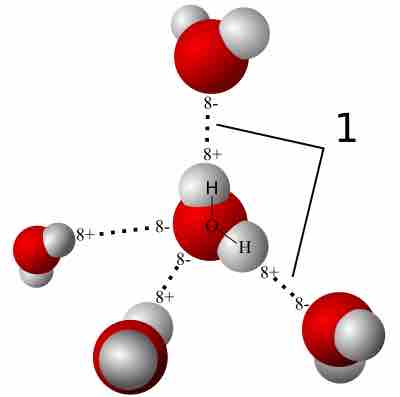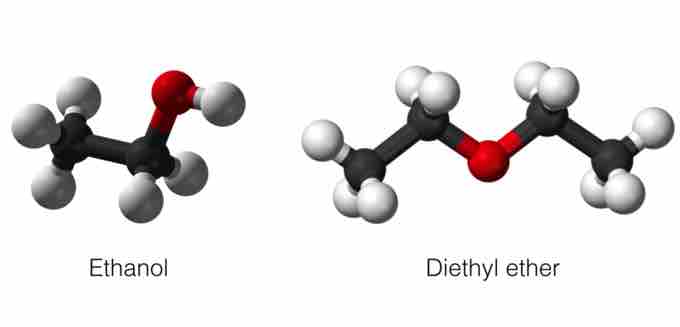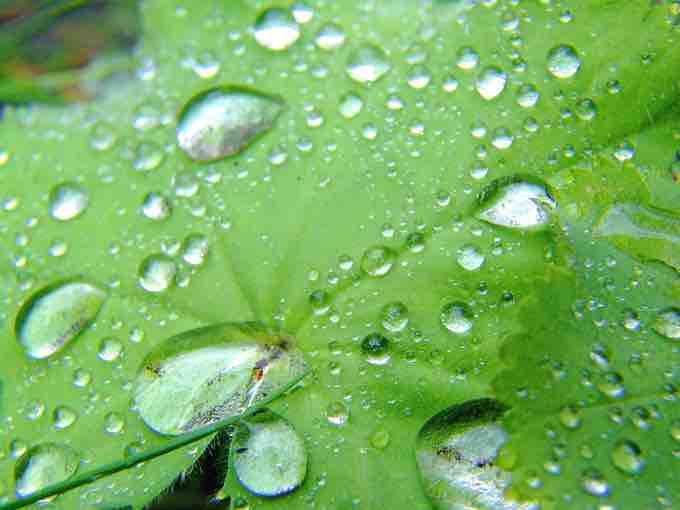Forming a Hydrogen Bond
A hydrogen bond is the electromagnetic attraction created between a partially positively charged hydrogen atom attached to a highly electronegative atom and another nearby electronegative atom. A hydrogen bond is a type of dipole-dipole interaction; it is not a true chemical bond. These attractions can occur between molecules (intermolecularly) or within different parts of a single molecule (intramolecularly).

Hydrogen bonding in water
This is a space-filling ball diagram of the interactions between separate water molecules.
Hydrogen Bond Donor
A hydrogen atom attached to a relatively electronegative atom is a hydrogen bond donor. This electronegative atom is usually fluorine, oxygen, or nitrogen. The electronegative atom attracts the electron cloud from around the hydrogen nucleus and, by decentralizing the cloud, leaves the hydrogen atom with a positive partial charge. Because of the small size of hydrogen relative to other atoms and molecules, the resulting charge, though only partial, is stronger. In the molecule ethanol, there is one hydrogen atom bonded to an oxygen atom, which is very electronegative. This hydrogen atom is a hydrogen bond donor.
Hydrogen Bond Acceptor
A hydrogen bond results when this strong partial positive charge attracts a lone pair of electrons on another atom, which becomes the hydrogen bond acceptor. An electronegative atom such as fluorine, oxygen, or nitrogen is a hydrogen bond acceptor, regardless of whether it is bonded to a hydrogen atom or not. Greater electronegativity of the hydrogen bond acceptor will create a stronger hydrogen bond. The diethyl ether molecule contains an oxygen atom that is not bonded to a hydrogen atom, making it a hydrogen bond acceptor.

Hydrogen bond donor and hydrogen bond acceptor
Ethanol contains a hydrogen atom that is a hydrogen bond donor because it is bonded to an electronegative oxygen atom, which is very electronegative, so the hydrogen atom is slightly positive. Diethyl ether contains an oxygen atom that is a hydrogen bond acceptor because it is not bonded to a hydrogen atom and so is slightly negative.
A hydrogen attached to carbon can also participate in hydrogen bonding when the carbon atom is bound to electronegative atoms, as is the case in chloroform (CHCl3). As in a molecule where a hydrogen is attached to nitrogen, oxygen, or fluorine, the electronegative atom attracts the electron cloud from around the hydrogen nucleus and, by decentralizing the cloud, leaves the hydrogen atom with a positive partial charge.
Applications for Hydrogen Bonds
Hydrogen bonds occur in inorganic molecules, such as water, and organic molecules, such as DNA and proteins. The two complementary strands of DNA are held together by hydrogen bonds between complementary nucleotides (A&T, C&G). Hydrogen bonding in water contributes to its unique properties, including its high boiling point (100 °C) and surface tension.

Water droplets on a leaf
The hydrogen bonds formed between water molecules in water droplets are stronger than the other intermolecular forces between the water molecules and the leaf, contributing to high surface tension and distinct water droplets.
In biology, intramolecular hydrogen bonding is partly responsible for the secondary, tertiary, and quaternary structures of proteins and nucleic acids. The hydrogen bonds help the proteins and nucleic acids form and maintain specific shapes.